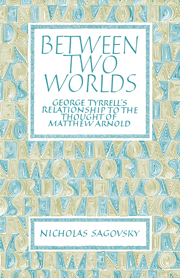Book contents
- Frontmatter
- Contents
- Acknowledgments
- Abbreviations and note on references
- 1 Tyrrell and Arnold ‘between two worlds’
- 2 The history of an opinion
- 3 ‘Definite evidence’
- 4 Fundamental convergence: epistemology and metaphysics
- 5 The life of the spirit: ecclesiology and culture
- 6 Christology: the parting of the ways
- 7 God, and ‘the Power that makes for Righteousness’
- 8 Conclusions
- Appendix Two letters to the Abbé Venard
- Notes
- Select bibliography
- Index
1 - Tyrrell and Arnold ‘between two worlds’
Published online by Cambridge University Press: 23 October 2009
- Frontmatter
- Contents
- Acknowledgments
- Abbreviations and note on references
- 1 Tyrrell and Arnold ‘between two worlds’
- 2 The history of an opinion
- 3 ‘Definite evidence’
- 4 Fundamental convergence: epistemology and metaphysics
- 5 The life of the spirit: ecclesiology and culture
- 6 Christology: the parting of the ways
- 7 God, and ‘the Power that makes for Righteousness’
- 8 Conclusions
- Appendix Two letters to the Abbé Venard
- Notes
- Select bibliography
- Index
Summary
On 7 September 1851, with his new wife Fanny Lucy, Matthew Arnold climbed through a freezing mist high in the Alps to visit the ancient monastery of the Grande Chartreuse. A stranger, a married man, a Protestant, for one brief night he entered the religious world of the Middle Ages, retiring at half-past seven and rising at eleven to join the monks for midnight mass. Here, in the chill and clinging damp, he watched cowled figures with white faces chant the service by the light of flickering tapers as they had done for almost eight hundred years. Here the monks maintained a belief that had once been that of all Christendom. The son of Dr Arnold was captivated.
Matthew Arnold's own, largely eroded, Christianity had been formed in the demanding atmosphere of Rugby chapel, where the preaching of his father concentrated on moral integrity and maintained towards the imaginative fullness of medieval Roman Catholicism a sharp critical detachment. He had surrendered his belief in the resurrection and atonement some years before, feeling that neither the devotion of the Carthusians, nor that of his father was possible ‘for both were faiths, and both are gone’. Since there was no help on the mountaintop he could only return with his wife from the Grande Chartreuse to the ‘darkling plain’, and there continue his search for a faith which combined continuity with the past and openness to the future. He was left
Wandering between two worlds, one dead,
The other powerless to be born.
- Type
- Chapter
- Information
- Between Two WorldsGeorge Tyrrell's Relationship to the Thought of Matthew Arnold, pp. 1 - 12Publisher: Cambridge University PressPrint publication year: 1983

